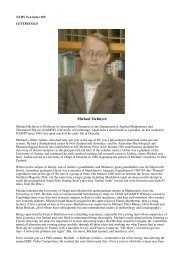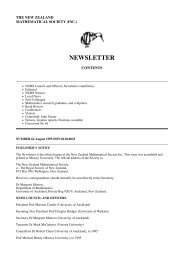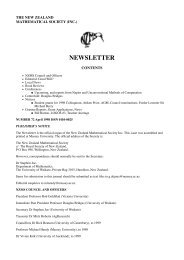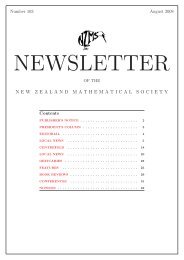Centrefold - David Benney - New Zealand Mathematical Society
Centrefold - David Benney - New Zealand Mathematical Society
Centrefold - David Benney - New Zealand Mathematical Society
Create successful ePaper yourself
Turn your PDF publications into a flip-book with our unique Google optimized e-Paper software.
NZMS <strong>New</strong>sletter #88<br />
CENTREFOLD<br />
<strong>David</strong> <strong>Benney</strong><br />
<strong>David</strong> J. <strong>Benney</strong> was born in <strong>New</strong> <strong>Zealand</strong> and spent most of his early years in Wellington. He was educated at<br />
Wellington Boys' College where he excelled in languages! His father, Cecil <strong>Benney</strong>, was Undersecretary of Mines<br />
for many years. Dave <strong>Benney</strong> graduated from Victoria University of Wellington with a Bachelors in Science (1950)<br />
with first class honours in Mathematics and a Master's in Science in (1951). Subsequently he went to Emmanuel<br />
College, Cambridge University where he took the <strong>Mathematical</strong> Tripos. He returned to <strong>New</strong> <strong>Zealand</strong> where he<br />
taught at Canterbury University College in 1955-56 and then went to the Massachusetts Institute of Technology<br />
(1957-59) where he earned a Ph.D. in Mathematics, studying with C. C. Lin. He has been at MIT ever since, holding<br />
posts of Instructor, Assistant Professor, Associate Professor, Professor (since 1966) and Head of the Department<br />
(1989-1999).<br />
Dave met his wife Elizabeth at Canterbury when she was finishing her degree. They were on a group ski trip to<br />
Temple Basin in 1955 and were married in 1959. Elizabeth <strong>Benney</strong> is well known for her remarkable<br />
accomplishments in the equestrian world and as a published author. They purchased an abandoned 77 acre farm in<br />
Upton, Massachusetts and brought it back to life. They built stables, a house, restored fields, installed fences etc. and<br />
made it into a beautiful horse farm. While this was in progress they lived in the original hundred year old farm house<br />
that was in very rough shape! Dave and Liz have three children and two grandchildren. They frequently visit <strong>New</strong><br />
<strong>Zealand</strong>.<br />
There's a lovely story which illustrates Dave <strong>Benney</strong>'s understated character. Dave worked in the garden at the N.Z.<br />
Government House during the summer holidays. Sometimes the Governor General, Sir Bernard Freyberg, would<br />
walk around and talk about the tomatoes, strawberries etc. with Dave. In the meantime, Dave was nominated for a<br />
prestigious scholarship and Freyberg was to be the interviewer. On the day of the interview, Dave worked in the<br />
garden and ran home at lunchtime to change into a suit. When the interview started, Freyberg said: “Haven't I met<br />
you You look familiar!” DJB never let on he was his gardener!<br />
In 2002 volume 108 of {\it Studies in Applied Mathematics} was dedicated as a tribute to <strong>Benney</strong> in recognition for<br />
his groundbreaking research contributions to applied mathematics and for being Managing Editor of “Studies” for<br />
over 30 years. The volume consists of an expository article by C.C. Lin and eight papers by colleagues and former<br />
students of <strong>David</strong> <strong>Benney</strong>. <strong>Benney</strong>'s work covers a range of issues of wide interest in physical applied mathematics:<br />
basic problems in fluid dynamics including flow stability and transition to turbulence, fundamental phenomena in<br />
nonlinear wave motion and asymptotic analysis. A preface article “Research Contributions of <strong>David</strong> J. <strong>Benney</strong>” by<br />
M. J. Ablowitz, T.R. Akylas and C.C. Lin surveys many of his important research contributions. The present article<br />
summarizes some of the earlier review and puts into perspective some of <strong>Benney</strong>'s influential work. The reader is<br />
encouraged to consult the above volume, articles and references for more information.<br />
His research work was often carried out in collaboration with his graduate students; he directed 18 Ph.D students.<br />
Such collaborations helped bring up younger generations many of whom made significant contributions of their<br />
own, thus amplifying the impact of his own effort. He is well-known at MIT as one of the best classroom lecturers at<br />
both the graduate and undergraduate levels. In collaboration with his colleague Harvey Greenspan, he co-authored<br />
an important calculus textbook which in addition to fundamentals encompasses both mathematical principles and the
processes of mathematical modeling. This book combines the 'spirit' of both pure and applied mathematics. The past<br />
half century has been a period of rapid progress in understanding nonlinear phenomena, and the work of <strong>David</strong><br />
<strong>Benney</strong> is central to this remarkable success. While his papers deal primarily with classical problems in fluid<br />
dynamics and nonlinear waves, <strong>Benney</strong>'s work has had lasting impact in various other fields as well, including<br />
meteorology, oceanography, optics and plasma physics.<br />
<strong>Benney</strong> recognized that valuable insights associated with nonlinear phenomena can be gained by working with<br />
relatively simple generic evolution equations that capture the underlying physics in certain asymptotic regimes<br />
relevant in a variety of physical contexts. This approach to nonlinear problems has proved particularly fruitful, and<br />
several of <strong>Benney</strong>'s papers have become true classics.<br />
<strong>Benney</strong>'s work on hydrodynamic stability and transition deals with essentially parallel flows such as that in the<br />
boundary layer over a flat plate. Beginning with his doctoral thesis, “On the Secondary Motion Induced by<br />
Oscillation in a Shear Flow”, <strong>Benney</strong> made decisive contributions to the theory of transition to turbulence through<br />
his studies of the nonlinear interactions of linear instability modes. <strong>Benney</strong> understood that interacting wavetrains<br />
have much in common with coupled nonlinear oscillators, and that the asymptotic procedures (multiple scales,<br />
averaging, Poincare frequency shifts etc.) developed for treating oscillator problems could be adapted to handle<br />
interacting waves.<br />
The mathematical analysis used to study nonlinear interactions of unstable modes in shear flows was the basis of<br />
<strong>Benney</strong>'s seminal work on nonlinear resonant interactions of gravity water waves. The spurious 'secular' growth of<br />
certain resonant wave components that had been found in earlier works on water waves was shown to be a<br />
manifestation of significant energy exchanges among waves that are members of resonant 'quartets'. This resonance<br />
mechanism has wide applicability in nonlinear dispersive wave systems.<br />
In 1964 <strong>Benney</strong> derived a system of equations approximating the dynamics of three-dimensional weakly nonlinear<br />
shallow-water waves and obtained a class of interacting solitary-wave solutions. Solitary waves and their interaction<br />
properties have been a topic of keen interest to researchers. Shallow-water waves are disturbances whose<br />
lengthscales are long compared to the depth, and different aspects of long-wave phenomena is a subject to which<br />
<strong>Benney</strong> returned periodically. The 1964 work, in particular, made clear why certain classical equations derived by<br />
mathematicians in the late 1800's by Boussinesq and by Korteweg and de Vries were actually generic<br />
approximations of weakly nonlinear-weakly dispersive wave phenomena. Hence, these equations applied in many<br />
different contexts.<br />
In subsequent work on weakly nonlinear modulated wavepackets in 1967 the celebrated nonlinear Schrödinger<br />
(NLS) equation was proposed as the canonical evolution equation governing the propagation of a slowly varying<br />
wavepacket envelope. Interestingly enough, the broad validity of the NLS equation was not fully appreciated at<br />
first—thirty five years ago, when the NLS equation was viewed as one of several proposed asymptotic approaches<br />
for studying the then recently discovered modulational (Benjamin-Feir) instability of nonlinear periodic water<br />
wavetrains. However, the NLS equation is now generally understood to be the proper evolution equation governing<br />
the envelope of weakly nonlinear wave pulses and, among other applications, has been at the centre of major recent<br />
technological advances in fibre optics.<br />
An important extension of the NLS equation to account for three-dimensional modulations of water wavepackets in<br />
finite depth was found in 1969. This work pointed attention to the coupling of the envelope with an induced<br />
mean-flow component which plays an important part in oblique instabilities of periodic wavetrains in water of finite<br />
depth. A coupled system of equations which governs the evolution of the wave envelope and the induced mean flow<br />
was derived. A special case of this system which is obtained in the limit of small fluid depth—sometimes also<br />
referred to as the Davey-Stewartson equations—has received considerable attention since it is an integrable 2+1<br />
dimensional system and is a prototype model of nonlinear interactions between short and long waves.<br />
<strong>Benney</strong> made further significant contributions to the theory of long-crested nonlinear waves in 1966. He devised an<br />
ingenious perturbation procedure to establish that the Korteweg–de Vries (KdV) equation is the appropriate<br />
evolution equation for weakly nonlinear long waves in a variety of flow systems—in the presence of density<br />
stratification, shear and rotation. This work went far beyond the classical problem of irrotational waves in shallow<br />
water and the result has been of central importance to other areas of fluid dynamics. He employed a similar<br />
perturbation approach to analyze waves on thin films, a problem of importance in coating and other manufacturing<br />
processes. In this instance, nonlinear, dispersive as well as instability effects are present; the resulting evolution<br />
equation has been studied extensively and has brought out a number of interesting physical phenomena.<br />
<strong>Benney</strong> was also the first to draw attention to nonlinear critical layers in parallel shear flows. In 1969 a class of<br />
finite-amplitude neutrally stable shear-flow modes was obtained in which nonlinearity dominates viscosity at the<br />
critical layer. These disturbances are governed by an eigenvalue problem quite different from that furnished by the<br />
classical linear viscous theory. This interesting possibility is now known to be relevant in various instances, and<br />
further studies which include stratification and rotation, as well as unsteady and wavepacket effects have been<br />
carried out by many others, including <strong>Benney</strong>.<br />
In 1970 <strong>Benney</strong> derived the asymptotic equations governing slowly varying multiperiodic wave trains in a class of
nonlinear systems. This was the first time modulations of fully nonlinear multiphase wave systems were obtained,<br />
extending earlier work from modulations of singly periodic to quasi-periodic waves. Similar asymptotic equations<br />
and their solutions, which involve algebro-geometric constructions, have been actively studied during the past 30<br />
years and are still a topic of considerable interest.<br />
In his seminal 1973 work on strongly nonlinear surface waves in shallow water <strong>Benney</strong> derived a novel system of<br />
nonlinear equations and showed that they admitted an infinite number of conservation laws. This system, which is<br />
referred to as the “<strong>Benney</strong> Equations”, have been intensively studied. While its complete solution is still not known,<br />
the properties already uncovered are so intriguing that undoubtedly the <strong>Benney</strong> equations will continue to be<br />
carefully investigated for years to come.<br />
During the eighties and the nineties, in parallel with his duties as Department Head of Mathematics, <strong>Benney</strong><br />
continued his work on nonlinear wave interactions and flow instability. Among other contributions, he pointed out<br />
that instabilities with algebraic, rather than exponential, growth can become important under conditions of 'direct<br />
resonance' owing to generalized eigenfunctions corresponding to degenerate eigenvalues in non-conservative<br />
systems. He also proposed a theory for shear-flow instability that provides an explanation for the significant threedimensional<br />
distortion of the mean flow which has been observed experimentally and which cannot be accounted for<br />
by classical weakly nonlinear theories.<br />
I wish to thank Liz <strong>Benney</strong> for relating the many interesting personal items to me.<br />
John Buckleton














